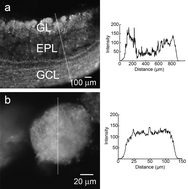Zinc released from olfactory bulb glomeruli by patterned electrical stimulation of the olfactory nerve
Abstract
Zinc is a trace element with a multitude of roles in biological systems including structural and cofactor functions for

* Corresponding authors
a Department of Biological Science, The Florida State University, Tallahassee, FL, USA
b Program in Neuroscience, The Florida State University, Tallahassee, FL, USA
c Department of Chemistry, Massachusetts Institute of Technology, Cambridge, MA, USA
Zinc is a trace element with a multitude of roles in biological systems including structural and cofactor functions for

 Please wait while we load your content...
Something went wrong. Try again?
Please wait while we load your content...
Something went wrong. Try again?
 Fetching data from CrossRef.
Fetching data from CrossRef.
This may take some time to load.
Loading related content
